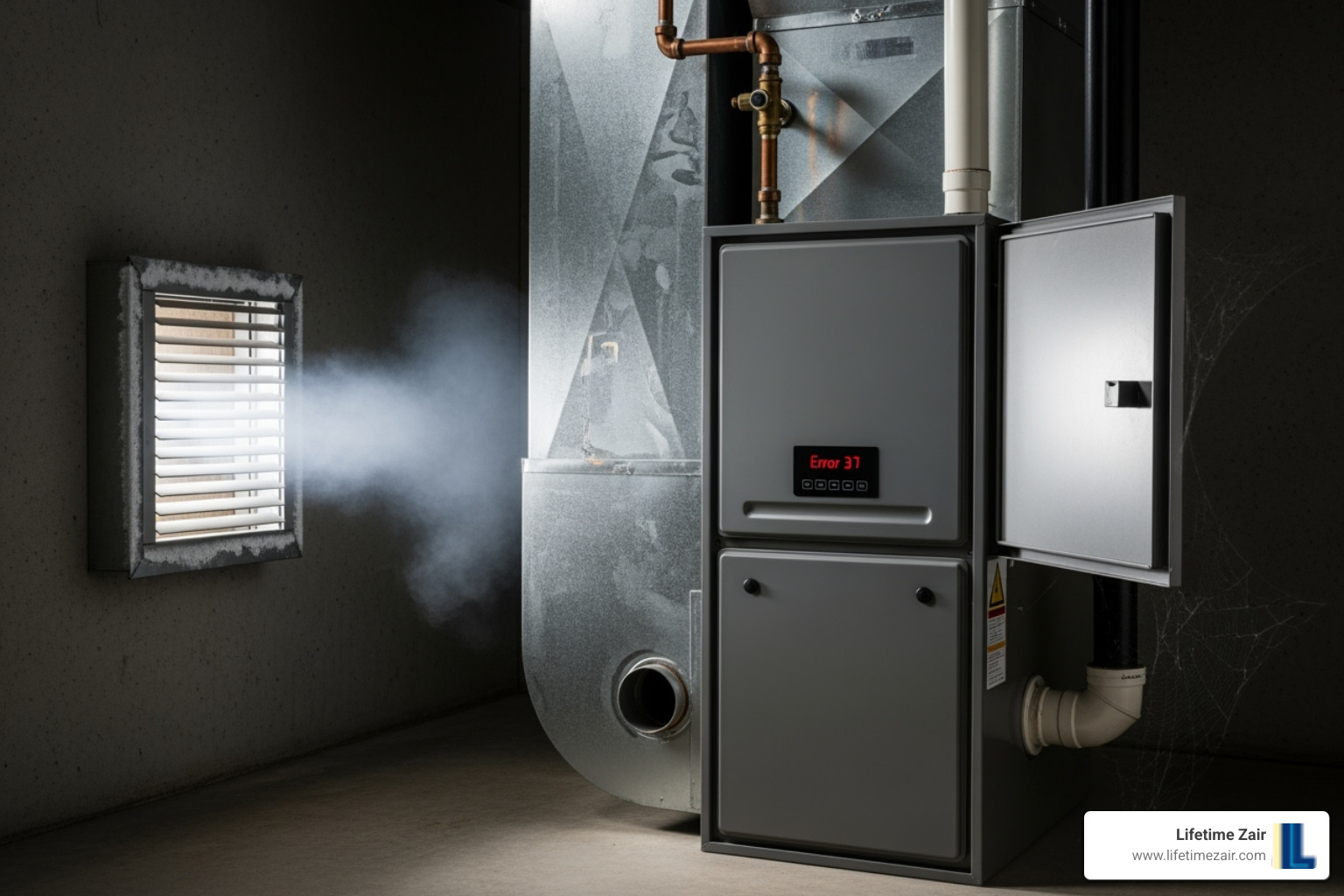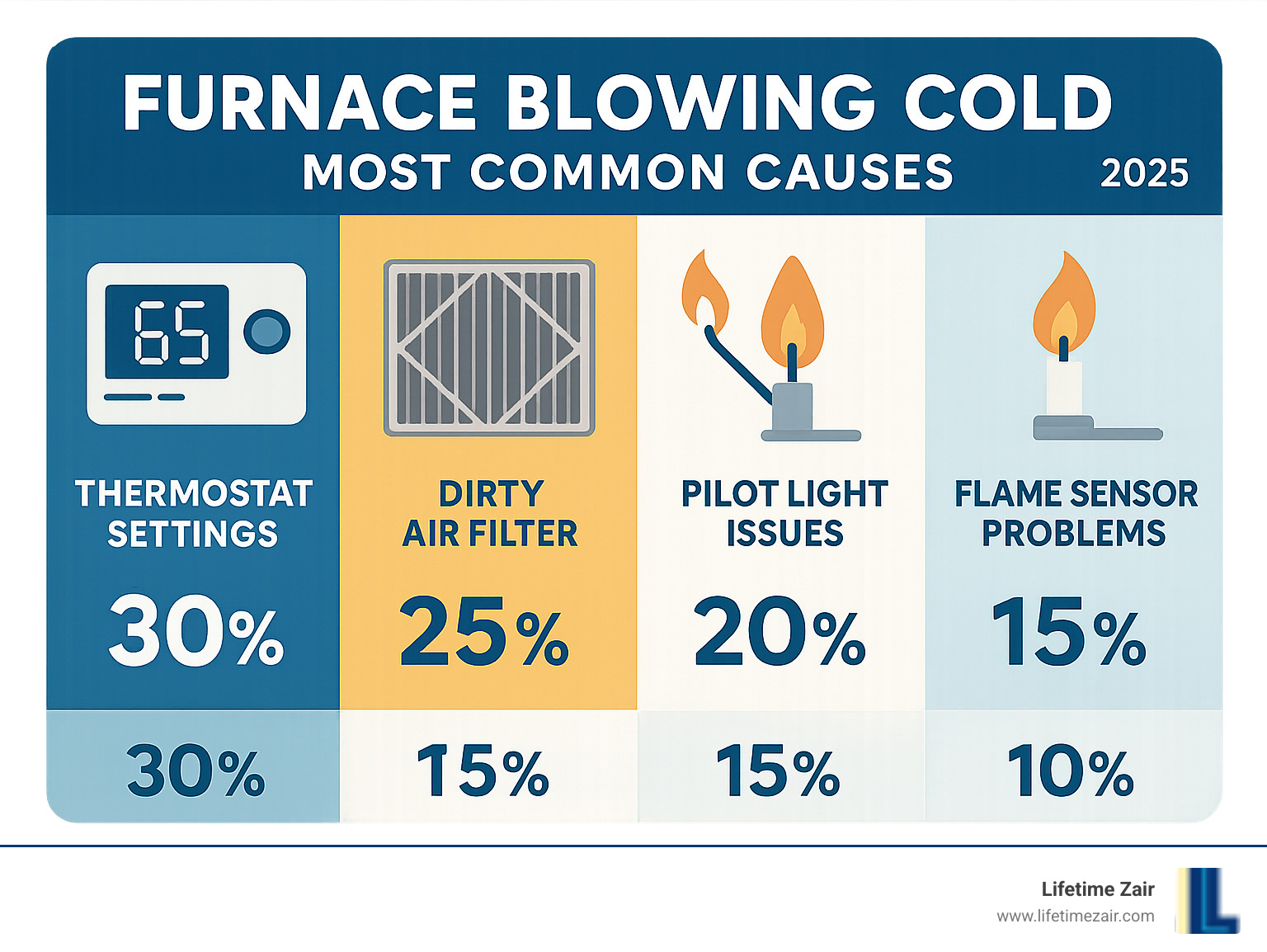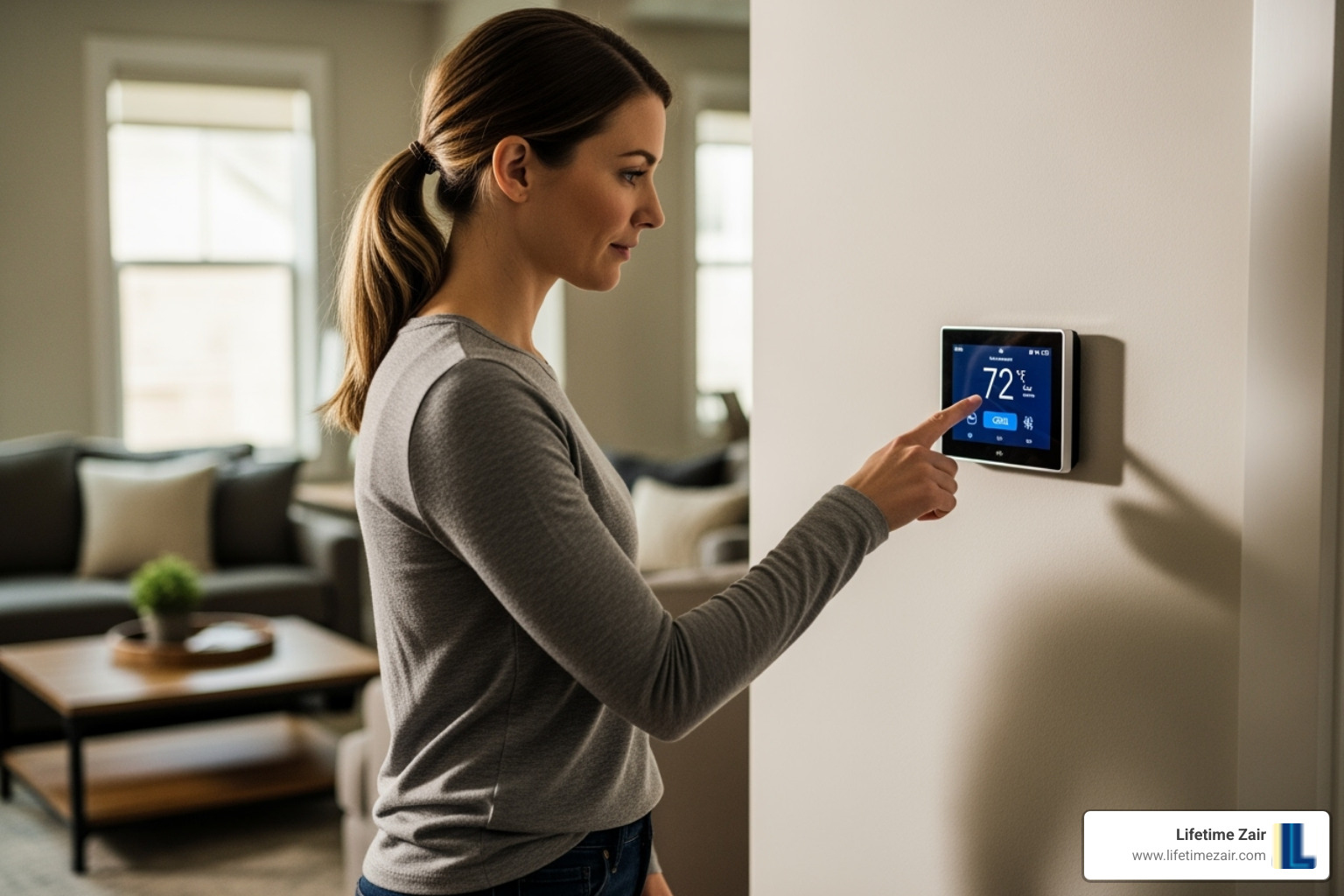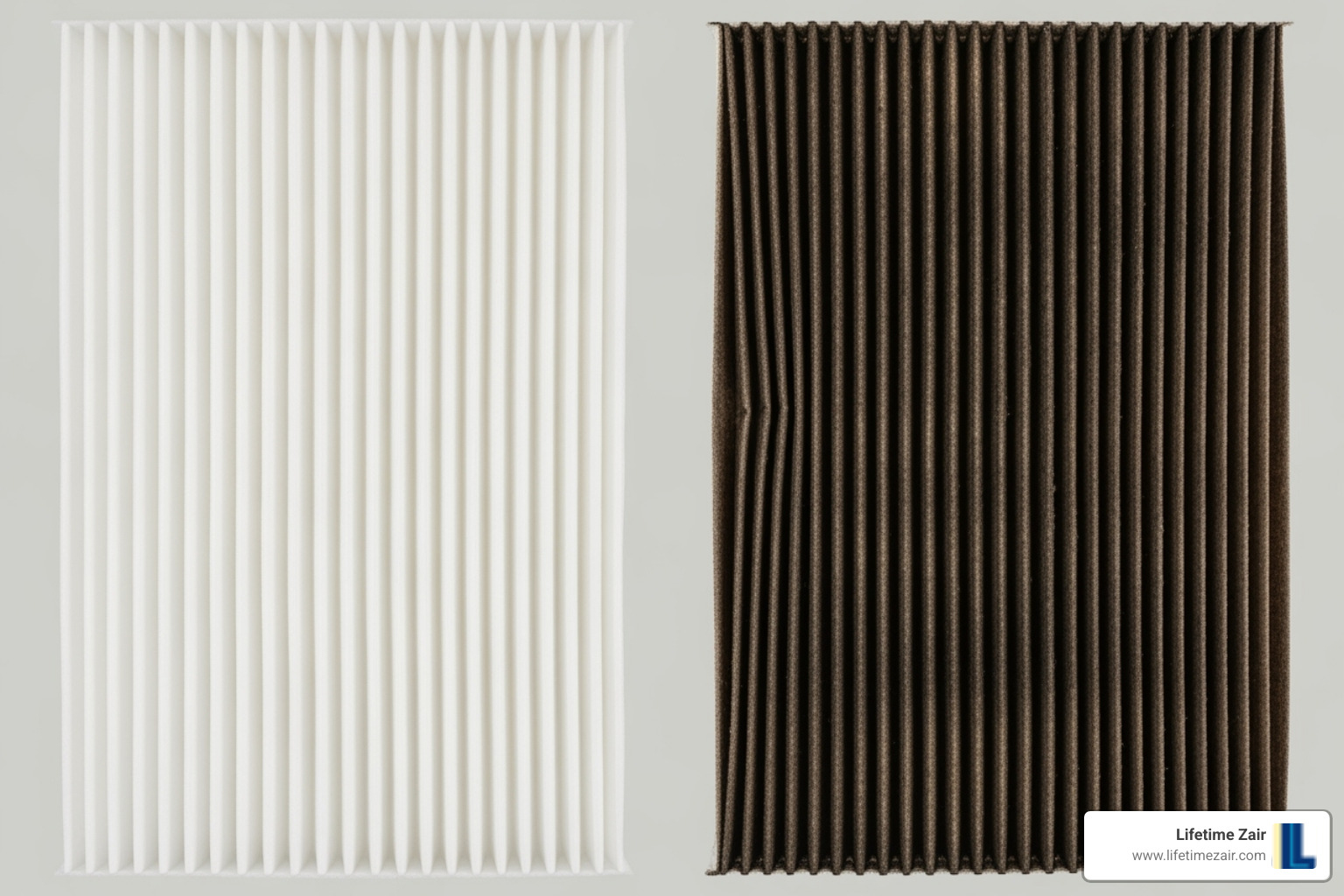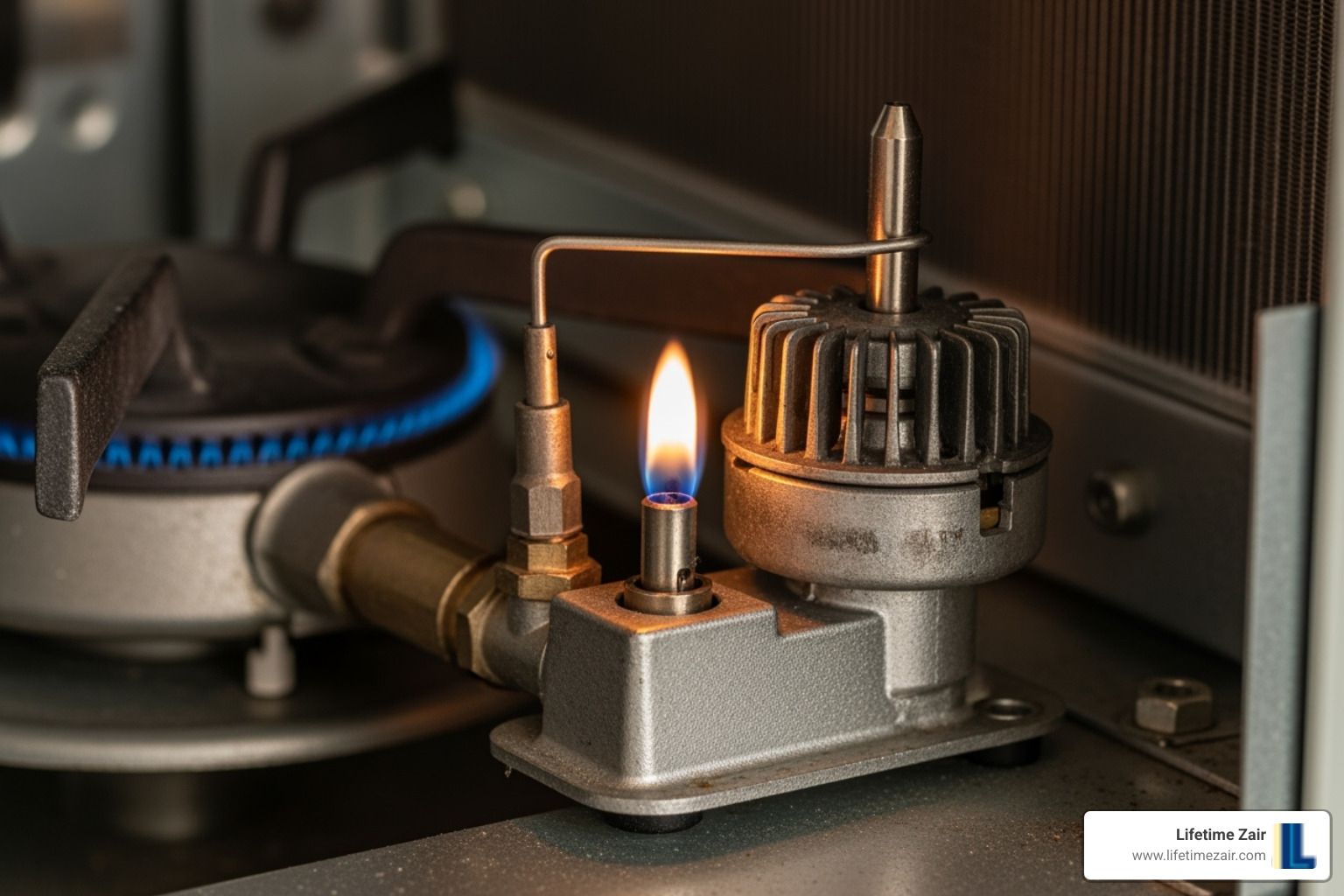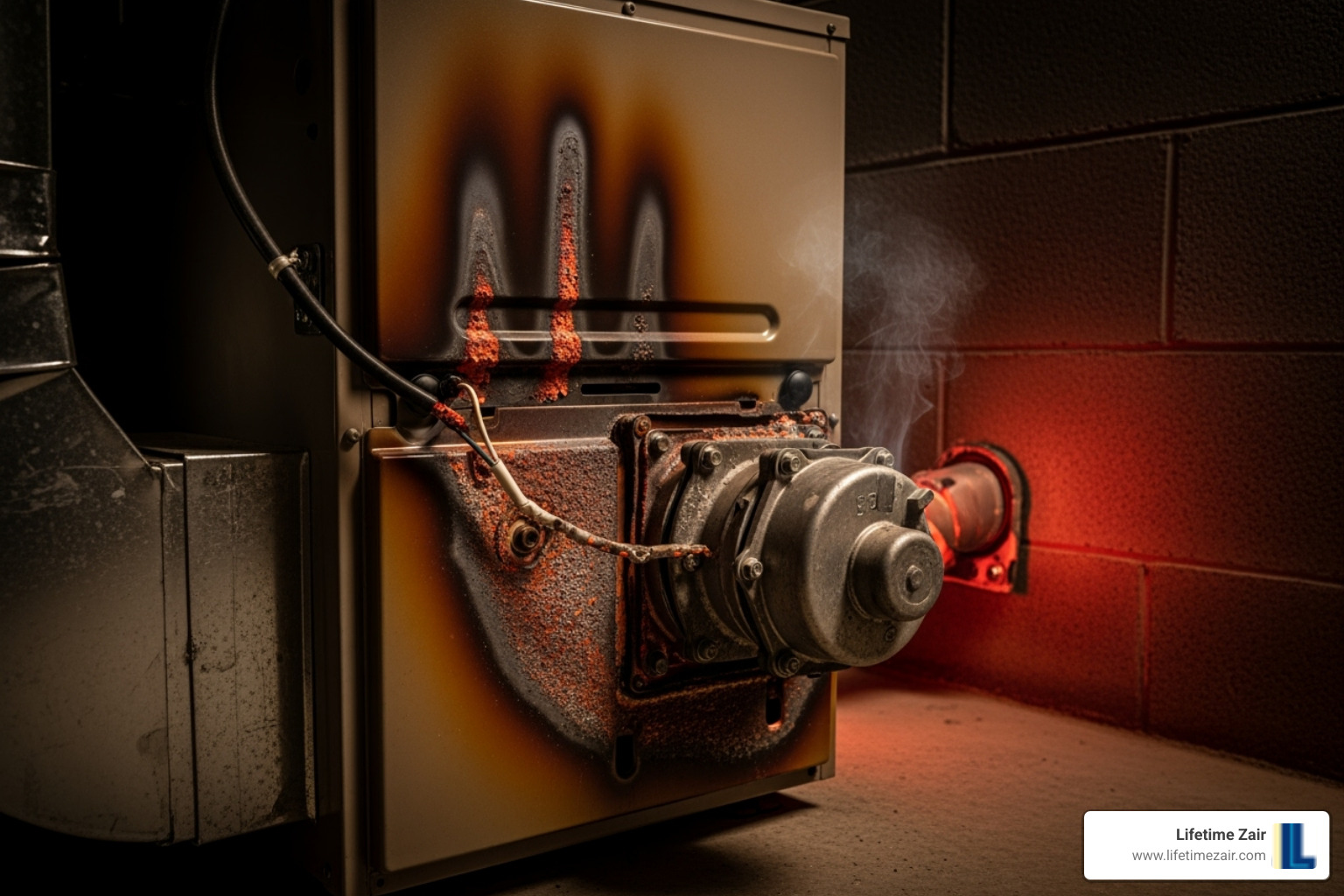When Your Furnace Becomes Your Worst Enemy
Furnace blowing cold air when you need heat most is like having your car break down in the middle of nowhere – frustrating, uncomfortable, and always happening at the worst possible time. As one homeowner put it: “You’re inside your home, beginning to shiver as the temperature outside dips lower and lower. So you go to turn on your furnace, looking forward to your furnace blowing hot air. Instead, you’re greeted by the furnace deciding to blow cold air.”
Quick Answer: Top Reasons Your Furnace Blows Cold Air
- Thermostat Issues – Wrong settings, dead batteries, or fan set to “On” instead of “Auto”
- Dirty Air Filter – Blocks airflow, causes overheating, triggers safety shutoff
- Pilot Light Problems – Out or damaged pilot light prevents ignition
- Flame Sensor Issues – Dirty sensor causes furnace to shut off gas supply
- Gas Supply Problems – Low gas or blocked lines prevent proper heating
Don’t panic yet. Many of these problems have simple fixes you can try before calling a professional. A dirty air filter alone causes about 80% of furnace problems, and it takes just minutes to replace.
When It’s Normal vs. When to Worry
Your furnace will blow cool air for the first few minutes after startup – this is completely normal. The system needs time to warm up, just like your car on a cold morning. But if cold air keeps coming after 10-15 minutes, you’ve got a real problem that needs fixing.
Simple DIY Checks You Can Do Right Now
When your furnace is blowing cold air, your first instinct might be to call for help immediately. But hold on – before you spend money on a service call, there are several simple fixes you can try right now. You’d be amazed how often the solution is something you can handle in just a few minutes.
Think of this as detective work. We’re going to check the most common culprits one by one, starting with the easiest fixes first. These simple steps solve about 70% of cold air problems we see.
Let’s start with your thermostat – the command center of your heating system. Walk over and take a close look at it right now. Is it set to “Heat” mode? You’d be surprised how many times we get calls where the thermostat was accidentally switched to “Cool” or “Off.”
Next, check the temperature setting. Make sure it’s set at least 5 degrees higher than the current room temperature. If it’s only 1-2 degrees higher, the furnace might not kick on consistently.
Here’s a big one: look at the fan setting. If it says “On,” switch it to “Auto” immediately. When the fan is set to “On,” it runs constantly, even when the furnace isn’t heating. This means you’ll feel cold air blowing between heating cycles, making you think something’s wrong when it’s actually normal.
Don’t forget about batteries! If your thermostat display looks dim or is showing a low battery warning, swap in fresh batteries. A dying thermostat can’t properly communicate with your furnace.
Finally, if you have a programmable thermostat, double-check your schedule settings. Did daylight saving time mess things up? Did someone accidentally change the program? These little gremlins cause more problems than you’d think. For more details about thermostat and other issues, check out our guide on common furnace problems.
A Dirty Air Filter is Causing Your Furnace to Blow Cold Air
Here’s the truth: a dirty air filter causes about 80% of furnace problems, and it’s the easiest fix you’ll ever make. Yet somehow, it’s the most overlooked solution when people have a furnace blowing cold air.
Your air filter is like your furnace’s protective mask. It catches dust, pet hair, and all the stuff floating around your house before it can gunk up your expensive equipment. But when that filter gets packed full of debris, it’s like trying to breathe through a pillow.
When airflow gets restricted, your furnace starts overheating. Modern furnaces are smart – they have safety switches that detect when things get too hot. The safety system shuts off the burners to prevent damage, but the fan keeps running to cool everything down. Result? Cold air blowing through your vents.
The fix is embarrassingly simple. Turn off your furnace, find the filter (usually near where the big return duct connects), slide out the old one, and slide in a new one. Make sure the arrows on the filter frame point toward the furnace.
How often should you replace it? Every 1-3 months, depending on your household. Got pets? Every month. Live alone with no pets? Every 3 months is fine. The filter replacement frequency can make or break your system’s performance.
Look at that image above – the difference is dramatic. A clean filter lets air flow freely, while a dirty one chokes your system. If you’re seeing other warning signs beyond cold air, our guide on Signs You Need Furnace Repairs can help you figure out what’s normal and what needs professional attention.
Check Your Vents and Registers
Sometimes the simplest problems hide in plain sight. Blocked vents can make your furnace work harder and distribute air unevenly, creating cold spots throughout your home.
Take a walk through your house and play detective. Are any supply vents (where warm air comes out) covered by furniture, curtains, or that pile of laundry you’ve been meaning to fold? Even partially blocked vents disrupt the airflow balance your furnace needs to work properly.
Don’t forget about return vents – the larger vents that suck air back into your system. These are just as important as supply vents. When return vents get blocked, your furnace can’t pull enough air through the system, leading to poor heating and potential overheating.
Check your furniture placement too. That couch pushed against the wall might be covering a vent. Kids have a talent for dropping toys over floor vents. Even area rugs can block floor registers if they’re not cut properly.
Finally, look for damper settings in your ductwork. These are little handles or levers on the ducts themselves that control airflow to different areas. If a damper got accidentally closed during maintenance or construction, entire rooms can go without heat even though the furnace is running perfectly.
The goal is unrestricted airflow throughout your home. When air can move freely in and out of your furnace, everything works as designed. When it can’t, you get the frustrating problem of cold air when you need heat most.
Why Your Furnace is Blowing Cold Air: Deeper Issues
When you’ve tried all the simple fixes and your furnace is still blowing cold air, it’s time to look at what’s happening inside the unit itself. These problems involve the heart of your heating system – the ignition system, blower motor, and control board that work together to create the warm air you desperately need.
Think of your furnace like a well-orchestrated team. Each component has a specific job, and when one player isn’t doing their part, the whole system suffers. While some of these issues might seem intimidating, understanding what’s going wrong can help you decide whether it’s a DIY project or time to call in the pros. If you’re feeling overwhelmed by all the technical terms, our HVAC Terminology guide can help translate the jargon.
Pilot Light or Ignition System Failure
Without a working ignition system, your furnace is basically just an expensive fan. The ignition system is what actually lights the gas that heats your home, so when it fails, you get all the air movement but none of the warmth – classic furnace blowing cold air territory.
If you have an older furnace (typically 15+ years old), it probably uses a pilot light – that little blue flame that burns continuously. When this pilot light goes out, your main burners can’t ignite. Common culprits include drafts near the furnace, a clogged pilot opening, or simply age-related wear and tear.
You can often relight a pilot light yourself by following the instructions on your furnace’s panel. Just remember to wait at least five minutes after turning off the gas before attempting to relight – safety first! If the flame keeps going out or burns yellow instead of blue, that’s a sign you need professional help. You can learn more about how a pilot light works if you’re curious about the mechanics.
Modern furnaces use electronic ignition instead of a pilot light. These systems are more efficient since they don’t waste gas keeping a flame burning 24/7, but they have their own quirks. The hot surface ignitor (that glowing element you might see) can burn out over time, or the intermittent pilot system can develop electrical issues. Unlike pilot lights, electronic ignition problems usually require a technician’s expertise to diagnose and repair safely.
Dirty Flame Sensor or Faulty Thermocouple
Even when your ignition system lights the gas perfectly, there’s another safety component watching to make sure everything stays safe. The flame sensor (in newer furnaces) and thermocouple (in older models) are like security guards for your heating system – they make sure there’s actually a flame before allowing gas to keep flowing.
When your flame sensor gets dirty – and it will over time – it can’t “see” the flame even though it’s right there. This causes your furnace to start up, run for maybe 30 seconds to a few minutes, then shut off when the sensor thinks the flame is gone. The result? Your furnace blowing cold air in frustrating cycles, starting and stopping repeatedly.
The good news is that cleaning a flame sensor is often a DIY job. Turn off the power to your furnace, locate the sensor (usually a thin metal rod near the burner), and gently clean it with fine steel wool or emery cloth. Just be gentle – you’re removing carbon buildup, not trying to polish it to a mirror shine.
Thermocouples in older furnaces work similarly but are harder to access and clean. When they fail, your pilot light will keep going out because the gas valve thinks it’s unsafe to stay open. These usually need professional replacement, but the good news is they’re relatively inexpensive parts.
Clogged Condensate Line
If you have a high-efficiency furnace (90% efficiency or higher), you’ve got another potential troublemaker: the condensate line. These efficient units extract so much heat from combustion that they actually produce water as a byproduct – kind of like how your car’s exhaust pipe drips water on cold mornings.
This water needs somewhere to go, and that’s where the condensate drain comes in. When this line gets clogged with algae, mold, or just plain old gunk, the water backs up and triggers an overflow kill switch. This safety feature immediately shuts down your furnace’s heating elements to prevent water damage, leaving you with a furnace blowing cold air and possibly some puddles around the unit.
You might be able to clear minor blockages yourself using a wet/dry vacuum or by pouring a mixture of vinegar and water down the drain line. However, if you’re not comfortable with the process or the problem keeps coming back, it’s time to call a professional. Recurring clogs often indicate bigger issues with the drain system that need expert attention.
When to Call a Professional: Signs of Serious Trouble
Sometimes your furnace blowing cold air isn’t just an inconvenience – it’s a red flag waving frantically, telling you to step back and call in the experts. While we love empowering homeowners with DIY solutions, certain furnace problems are like trying to perform surgery with a butter knife. They’re dangerous, complex, and absolutely require professional expertise.
Think of it this way: you wouldn’t rewire your house after watching a YouTube video, right? The same principle applies to serious furnace issues. When gas lines, electrical systems, or the structural integrity of your furnace are involved, it’s time to put down the tools and pick up the phone. Your safety and your family’s wellbeing are worth far more than the cost of a service call.
Here’s how to recognize when your cold air problem has crossed into “call the pros immediately” territory. And when you’re ready to find the right expert, our 7 Tips for Hiring an HVAC Contractor guide will help you choose wisely.
Leaky Ductwork
Imagine paying for a pizza delivery, but half the pizza falls out of holes in the delivery bag before it reaches your door. That’s essentially what happens with leaky ductwork – you’re paying to heat air that never makes it to your living space.
Your ductwork acts as the highway system for heated air, carrying warmth from your furnace to every room in your home. But when ducts develop leaks, holes, or loose connections, that precious heated air escapes into your attic, crawl spaces, or inside your walls. The result? Your furnace blowing cold air through the vents, or at least air that’s much cooler than it should be.
The numbers are pretty shocking. According to Energy Star, in a typical house, about 20 to 30 percent of the air moving through duct systems is lost due to leaks, holes, and poorly connected ducts. That’s like throwing money directly out the window every month on your utility bills.
You might notice uneven heating throughout your home – some rooms feel toasty while others remain stubbornly cold, no matter how high you crank the thermostat. Your high utility bills might also be a telltale sign that your heated air is taking an expensive detour.
While you might be tempted to slap some duct tape on visible leaks (ironically, duct tape isn’t great for ducts), professional duct sealing involves specialized equipment to locate hidden leaks and proper sealing techniques that last. A technician can perform a thorough duct inspection and ensure your entire system is properly sealed and insulated.
A Cracked Heat Exchanger is Making Your Furnace Blow Cold
This is the furnace problem that keeps HVAC technicians awake at night – and it should concern you too. A cracked heat exchanger isn’t just about comfort; it’s a serious safety hazard that can literally be life-threatening.
Your heat exchanger is like the heart of your furnace. It’s where combustion gases (including carbon monoxide) are separated from the air that circulates through your home. When this component develops cracks, two bad things happen: your furnace can’t efficiently transfer heat (hello, furnace blowing cold air), and dangerous gases can leak into your home’s air supply.
Carbon monoxide leak is the nightmare scenario here. This colorless, odorless gas is often called the “silent killer” for good reason. Symptoms of CO poisoning can start subtly – headaches, dizziness, nausea, and fatigue that you might mistake for the flu. In severe cases, carbon monoxide poisoning can lead to unconsciousness and death. The Mayo Clinic’s information on carbon monoxide dangers provides crucial details every homeowner should know.
Furnace age plays a huge role here. If your furnace is 15+ years old and suddenly blowing cold air, a cracked heat exchanger becomes a real possibility. The constant heating and cooling cycles over the years can cause metal fatigue and eventual cracking.
If you suspect a cracked heat exchanger – especially if you notice unusual odors, soot buildup, or a yellow, flickering burner flame – turn off your furnace immediately and call a professional. This isn’t a repair situation; a cracked heat exchanger almost always means it’s time for furnace replacement. Our guide on When to Consider Heater Replacement can help you steer this major decision.
Beyond ductwork and heat exchanger issues, several other red flags demand immediate professional attention. Gas supply issues can prevent your furnace from getting enough fuel to ignite or maintain a flame – this could involve problems with gas lines, your meter, or even broader utility issues that require specialized knowledge to diagnose safely.
Electrical problems in modern furnaces are increasingly complex. Today’s units have computerized control boards that manage intricate sequences of operations. When these fail, you might hear the blower running while the burners stay cold, leaving you with that frustrating furnace blowing cold air scenario.
Finally, trust your senses. Loud noises like grinding, banging, or squealing from your furnace are mechanical cries for help. Burning smells are even more urgent – they could indicate overheating components, electrical issues, or worse. When your nose or ears tell you something’s wrong, listen to them and call a professional immediately.
Frequently Asked Questions about a Furnace Blowing Cold Air
When your furnace is blowing cold air, it’s natural to have questions – and probably a few colorful words too! We get calls about these issues all the time, so you’re definitely not alone. Let’s tackle the most common questions we hear from homeowners dealing with chilly indoor temperatures.
How long should I wait for my furnace to blow hot air?
Here’s the thing – your furnace isn’t like flipping a light switch. It needs a little time to get its act together! When your furnace first kicks on, especially after being off for a while, it goes through what we call an initial startup and warm-up cycle.
Think of it like starting your car on a cold morning. The engine needs to warm up before it runs smoothly. Your furnace works the same way. The heat exchanger has to get hot enough to actually warm the air passing through it. Meanwhile, the blower fan often starts running before the burners are fully heated up – that’s the blower delay system working as designed.
Normal operation means you should start feeling warm air within a few minutes, but give it about 10-15 minutes before you start worrying. If your furnace is blowing cold air after that window, then you’ve got a real problem that needs attention.
Can a furnace blowing cold air be a fire hazard?
This is a great question, and honestly, it shows you’re thinking about safety – which we love to see! The short answer is yes, but not in the way you might think.
When your furnace is blowing cold air, it’s often because something has triggered the safety limit switch. This happens when your furnace starts overheating due to restricted airflow from a dirty filter or blocked vents. The safety switch is actually protecting you by shutting off the burners before things get dangerous.
But here’s the thing – the fan keeps running to cool down the overheated components. So while that cold air might feel annoying, it’s actually your furnace’s way of preventing a potential fire hazard. The real danger would be if these safety systems weren’t working at all.
That said, don’t ignore this warning sign! Address the root cause quickly. Preventative measures like changing your filter regularly and keeping vents clear can prevent these overheating situations entirely.
Why does my furnace blow hot air sometimes and cold air other times?
Ah, the classic Jekyll and Hyde furnace! This intermittent behavior is actually one of the most frustrating problems homeowners face. One minute you’re toasty warm, the next you’re reaching for a sweater. There are several reasons why your furnace might be playing this hot-and-cold game.
Thermostat settings are often the sneaky culprit. If your fan is set to “On” instead of “Auto,” it runs constantly – even when the furnace isn’t actively heating. That means you’ll get warm air during heating cycles and cool air in between.
Short cycling is another common cause. This happens when your furnace starts up, runs briefly, then shuts off before completing a full heating cycle. A dirty flame sensor can cause this – the furnace lights up, but the sensor can’t “see” the flame properly, so it shuts everything down as a safety measure.
Your furnace might also be stuck in an overheating cycle. It heats up, gets too hot, shuts down to cool off, then tries again. It’s like your furnace is having a mechanical anxiety attack! This usually points back to airflow problems.
The bottom line? If your furnace is blowing cold air inconsistently, it’s telling you something’s wrong. These intermittent issues rarely fix themselves and often get worse over time. It’s worth having a professional take a look before you end up with no heat at all on the coldest night of the year!
Stay Warm and Safe with Professional Furnace Service
We hope this guide has helped you understand why your furnace is blowing cold air and given you some practical solutions to try at home. While many issues can be resolved with simple DIY fixes, knowing when to call in the professionals is just as important as knowing how to troubleshoot on your own.
Think of your furnace like your car – it needs regular check-ups to keep running smoothly. Preventative maintenance is your best friend when it comes to avoiding those midnight emergencies when your heating system decides to take an unscheduled vacation. An annual tune-up isn’t just a nice-to-have; it’s essential for keeping your system running efficiently and safely.
During a professional maintenance visit, our certified technicians perform a comprehensive safety inspection of your entire heating system. We clean critical components, check gas connections, test safety switches, and calibrate your thermostat. This thorough approach helps us catch small problems before they turn into expensive repairs or leave you with a furnace blowing cold air on the coldest day of the year.
Regular maintenance also improves your system efficiency, which translates directly to lower energy bills. A well-maintained furnace doesn’t have to work as hard to heat your home, saving you money month after month. Plus, it extends the life of your equipment – and nobody wants to replace a furnace before they absolutely have to!
At Lifetime Zair, we understand that unexpected furnace problems can throw a wrench in both your comfort and your budget. That’s why we offer flexible financing options and promotions to make essential home comfort services accessible when you need them most. Our team of experienced professionals serves communities throughout the Dallas area, bringing reliable expertise right to your door.
Don’t wait until you’re shivering in your own home to address furnace issues. Whether you need emergency repair service, routine maintenance, or just want peace of mind knowing your heating system is ready for winter, we’re here to help.
Ready to ensure your heating system is in peak condition? Learn more about Why Schedule Furnace Service? or take the next step and Schedule your HVAC service in Dallas, TX with Lifetime Zair today. Let us help you stay warm, safe, and comfortable all season long.
